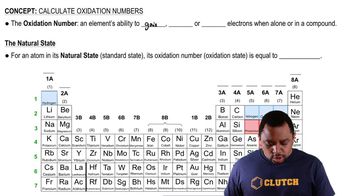Here are the essential concepts you must grasp in order to answer the question correctly.
Half-Reaction Method
The half-reaction method is a technique used to balance redox reactions by separating the oxidation and reduction processes. Each half-reaction is balanced for mass and charge, allowing for a clearer understanding of electron transfer. This method is particularly useful in complex reactions, as it simplifies the balancing process by focusing on individual components.
Recommended video:
Method 1 of Radioactive Half-Life
Balancing in Basic Solutions
When balancing redox reactions in basic solutions, hydroxide ions (OH<sup>-</sup>) are added to neutralize any hydrogen ions (H<sup>+</sup>) that appear during the balancing process. This ensures that the final balanced equation reflects the conditions of a basic environment. The addition of water may also be necessary to balance the number of oxygen atoms.
Recommended video:
Balancing Basic Redox Reactions
Oxidation States
Oxidation states are a way to keep track of electron transfer in redox reactions. Each element in a compound is assigned an oxidation state based on its electron configuration and bonding. Understanding oxidation states helps identify which species are oxidized and reduced, which is essential for correctly balancing half-reactions and determining the overall reaction.
Recommended video:
 Verified step by step guidance
Verified step by step guidance


